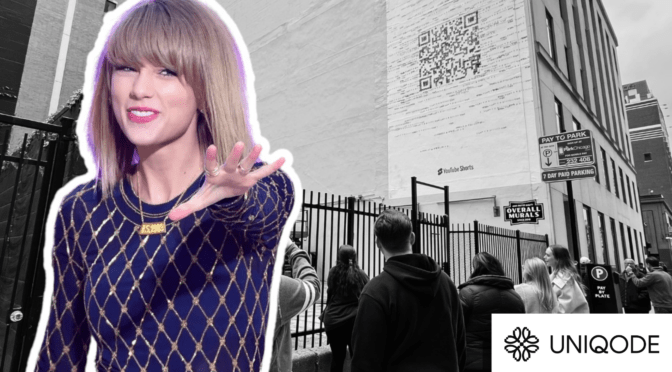Trailers for the Marvel Cinematic Universe summer blockbuster “Deadpool & Wolverine” were chock-full of references and Easter eggs, in typical MCU fashion. But only the most observant viewers spotted a sneaky addition to one of these promotional videos, something that has popped up in movies and marketing over the years.
Three seconds into a teaser that “Deadpool” star Ryan Reynolds posted on social media, a tiny QR Code briefly pops up between Wolverine’s knees. Scanning it with a camera will return a funny tongue-in-cheek video from Reynolds as a little reward for curious fans, basically acting as an advertisement within an advertisement.
Uniqode explored the trend of QR Codes in movies, television, and entertainment marketing through the years and why fans are seeing more of them.
In an increasingly digital world—and spurred by the need for touchless technology due to the COVID-19 pandemic—QR Codes have permeated the media space, serving as a clever marketing tool.
Seeing a prominent scannable square in the wild—whether it’s on a poster, a wall, or a screen—can invite curiosity from passersby. But by subtly weaving in QR Codes in teasers and filmed scenes in a blink-and-you’ll-miss-it kind of way, keen consumers can dig deeper into the hole, immersing themselves in supplemental material and other fun bonuses.
Producers and marketers are also hoping that these satisfied consumers, now proud of their find, would become vocal promoters of the show. Or, better yet, engaged viewers with eyes obsessively scrutinizing every scene.
In the Marvel Cinematic Universe, if you know, you know
Looking at the earlier days of the MCU, a poster for 2010’s “Iron Man 2” featured one of the earliest examples of QR Codes in movie marketing. A code prominently displayed in the middle of Tony Stark’s chest piece would take users to a website featuring a synopsis, images, the trailer, and ticket info for the film.
The QR Code was the central feature of that poster and indicated its importance, encouraging everyone who spots it to engage with it. Large codes on movie posters are impossible to miss, increasing the probability of engagement and also signaling to everyone that the code is official and trustworthy.
In the later MCU era, Marvel Studios utilized QR Codes in more subtle ways, placing the squares within their Disney+ streaming shows like “Moon Knight” and “She-Hulk: Attorney at Law.” This method works in part because QR Codes can be scanned from multiple angles. Filmmakers can then blend them into the elements of a scene without disturbing the action.
Viewers would pause the stream and scan the code on their phones, finding information about comics relating to the shows they were watching. These codes weren’t in-your-face like movie poster codes, but they were noticeable enough to catch the viewers’ attention and activate their impulse to explore, like when they see a phone number in a TV show (such as the one in the “Better Call Saul” trailer from 2014) and try to call it in real life.
Netflix and other filmmakers give QR Codes a shot
It’s easier to spot QR Codes and scan them when you can pause movies and shows in your home or rewind when you think you missed something. Streaming service Netflix took advantage of this strategy in several of its original films.
In the 2023 apocalyptic film “Leave the World Behind,” a hidden QR Code on a map of the United States led scanners to a website for the Lake Shawnee Abandoned Amusement Park in Mercer County, Kentucky. The link between this location and the movie isn’t explicit, but many viewers interpret it as thematic foreshadowing, with the empty and haunting amusement park similar to the deteriorating society depicted in the film.
The 2018 interactive film “Black Mirror: Bandersnatch” added a few more layers to engage audiences. A secret ending for the choose-your-own-adventure story includes a series of mysterious beeps that, when put through an emulator for retro computer ZX Spectrum, produce a QR Code. That code, in turn, links to a website for the fictional video game company depicted in “Bandersnatch.” All of these steps combined have the effect of fully placing the viewer in the film’s world.
Some Netflix media skipped all of the elaborate steps and thematic meaning, with a QR Code in the Ryan Reynolds, Dwayne Johnson, and Gal Gadot-starring comedy “Red Notice” redirecting scanners to a blooper reel filled with expletives that would have been hard to share widely.
Pop stars turn to QR Codes for album promotion
QR Codes have also entered the music industry, with global stars like Taylor Swift and Katy Perry running guerilla marketing campaigns to promote their upcoming albums.
Taylor Swift’s team used dynamic QR Codes as Easter Eggs in her The Tortured Poets Department album teaser campaign. These QR Codes on billboards in various cities led to unlisted YouTube Shorts containing cryptic clues. By deciphering these clues, fans discovered the album’s first single, “Fortnight.”
Katy Perry recently made headlines at the VMA’s Red Carpet. But it wasn’t because she won the highly coveted Video Vanguard Award or her edgy white dress, but a QR Code tattoo on the small of her back. Fans worldwide scanned this QR Code, leading them to a pre-save website for Perry’s upcoming studio album, 143.
A call for eagle-eye training and sleuthing
As studios and filmmakers continue to incorporate QR Codes in films, television, and their marketing, viewers will adapt to their growing prevalence and train themselves to seek them out.
Codes will be inserted in new ways and contexts, like in the 2024 HBO show “The Penguin,” which has someone handing the eponymous character a flyer with a QR Code that viewers themselves can scan.
Easter eggs like codes already reward those who pause every frame of a trailer to revel in every single detail, and many times, filmmakers and marketers won’t make these codes difficult to spot. But, in order to gain an extra edge, you could treat your vision as another muscle to train.
The International Sports Vision Association recommends a few exercises that can even help with everyday tasks, such as working in front of a computer monitor all day or driving. These exercises include training your eyes to watch a single point while your head is in motion, also known as “stability of fixation.” It involves fixing your eyes on an object while nodding your head “yes” or shaking your head “no.”
Another exercise recommended by the ISVA is meant to improve your peripheral vision. It involves finding a long hallway and trying to keep your eye on one target while simultaneously walking toward it and paying attention to the environment surrounding you. The next-level challenge involves the same exercise, but in a busy grocery store where many things are in motion.
If you find spotting QR Codes in the wild difficult, then one way to enjoy them is to do your own sleuthing online. Fans will naturally share any information they have about Easter eggs in Reddit forums, and entertainment sites will typically report on them as well. Better yet, strike up a conversation with fellow fans. The odds are that they can provide you with all the details.
If all else fails, there is always the more enjoyable exercise of simply watching more films and shows while being mindful of more than just the story unfolding. The best way to look out for QR Codes is to know that they can be anywhere at any time in a movie or show—if you’re looking for them, you’ll probably find them.
If not, take solace in the fact that you’re probably not alone. A small study conducted at Trinity College Dublin found that some people may innately be better at tracking fast-moving objects than others, but provides no clear reasons why.
“Because we only have access to our own subjective experience, we might naively expect that everyone else perceives the world in the same way we do,” Kevin Mitchell, a neurobiology professor at Trinity College Dublin who worked on the study, told The Guardian. “This study characterizes one such difference. Some people really do seem to see the world faster than others.”
Story editing by Carren Jao. Additional editing by Kelly Glass. Copy editing by Tim Bruns.

















